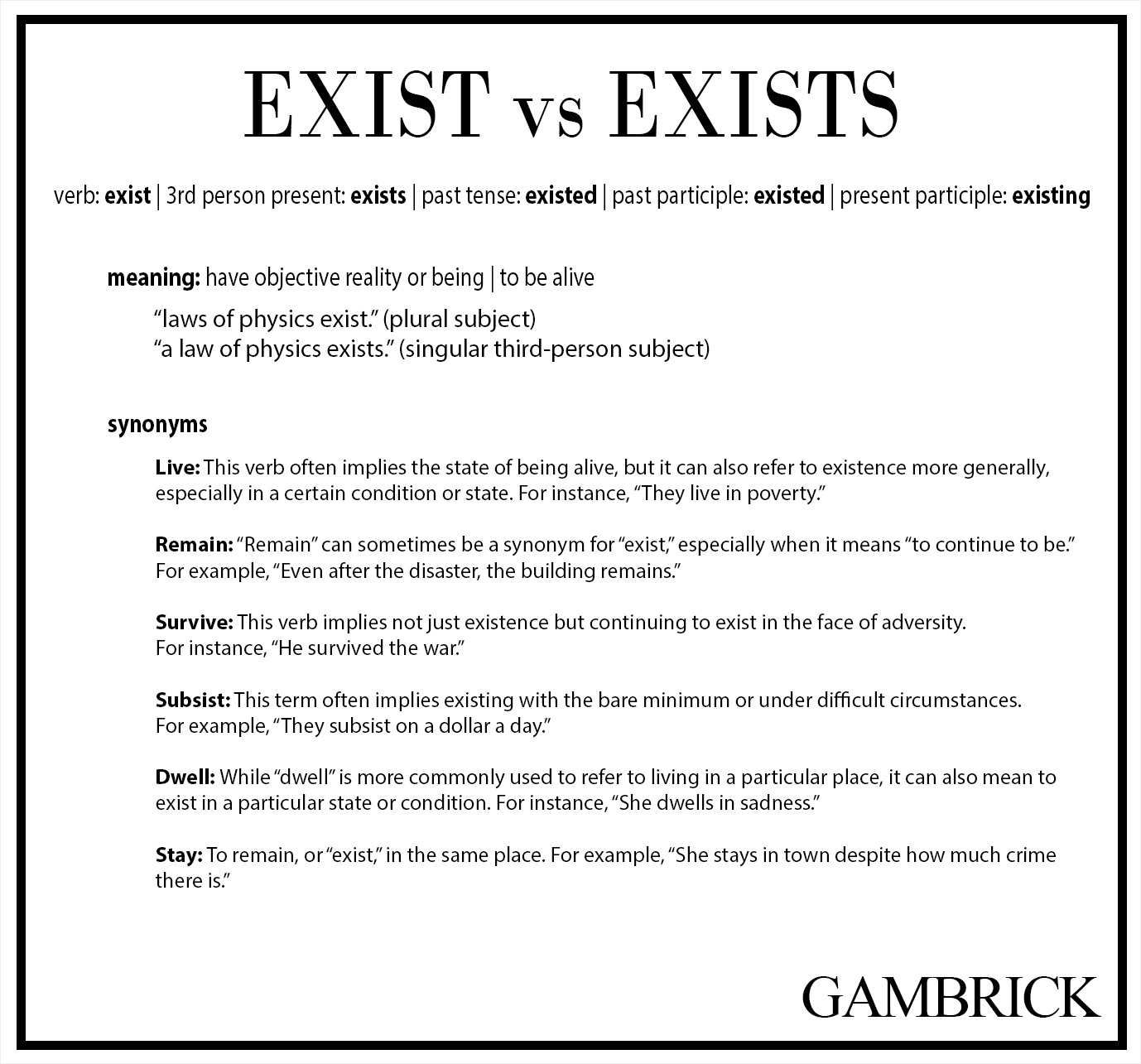The Difference Between Exist And Exists
Exist and exists are different forms of the same verb, which means to be real or alive. Although these two verbs are seemingly interchangeable, they follow grammatical rules that determine their correct usage. Understanding the nuanced differences between “exist” and “exists” can enhance the clarity and precision of your speech and writing.
“Exist” and “Exists” essentially communicate the same concept of ‘being.’ But the context and subject dictate which form you should use and when. “Exist” is typically used with plural subjects and the first-person singular pronoun “I”, while “exists” is generally used with singular third-person subjects.
- The verb “exist” indicates the state or fact of living or having objective reality. It’s used when something is real or present in a particular place or situation. This verb is widely used in formal and informal communication to assert the presence or reality of something.
- “Exists” is the third-person singular form of the verb “exist.” It’s used to denote the presence, occurrence, or reality of a singular subject in the third person, i.e., he, she, it, or any singular noun. It is often seen in formal, academic, or mathematical contexts to assert the existence of something.
The main difference between “exists” and “exists” is subject-verb agreement. “Exist” is used when the subject is plural or when the first-person singular pronoun “I” is the subject. On the other hand, “exists” is used when the subject is a singular third-person noun or pronoun (he, she, it).
Both “exist” and “exists” essentially mean the same thing and refer to the state of being or having objective reality. Understanding their correct usage is about context and the sentence’s subject to help convey meaning.
The Difference Between “Exist” And “Exists”
“Exist” and “Exists” essentially communicate the same concept of ‘being.’ But the context and subject largely dictate which form you should use. “Exist” is typically used with plural subjects and the first-person singular pronoun “I”, while “exists” is generally used with singular third-person subjects. The main difference between “exists” and “exists” is subject-verb agreement. “Exist” is used when the subject is plural or when the first-person singular pronoun “I” is the subject. On the other hand, “exists” is used when the subject is a singular third-person noun or pronoun (he, she, it).
Because “Exist” and “Exists” essentially mean the same thing, which word you use and when is more about context than meaning. They’re both verbs with the same meaning, but whether the subject is plural vs. singular dictates which word you should use when writing.
- For example: “Laws of physics exist.” (plural subject) “A law of physics exists.” (singular third-person subject)
Another difference is that “exist” is often employed when referring to multiple entities or a general concept, while “exists” is commonly used when referring to a single, specific entity.
- For example: “Parallel universes exist.” (general concept). “There exists a parallel universe where we made different choices.” (specific entity)
By understanding these differences, you’ll correctly use “exist” and “exists” in your writing and conversations. Remember, while both words communicate the same concept of ‘being,’ the context and subject largely dictate which form to use.
Basic Grammar Rules
The words “Exist” and “Exists” are both verbs. A verb is a word that expresses an action or state of being. They’re often used with a subject and an object. A verb can be transitive (take an object) or intransitive (not take an object). The verb’s subject can be a noun, a pronoun, or an entire clause.
| Exist | Exists |
| Have objective reality or being / to be real or alive. | Have objective reality or being / to be real or alive. |
| Used with plural subjects and the first-person singular pronoun “I.” | Is generally used with singular third-person subjects. |
| A transitive verb. | An intransitive verb. |
| The main form of the verb. | The third-person singular form of the verb. |
| “Laws of physics exist.” (plural subject). | “A law of physics exists.” (singular third-person subject). |
Verb tenses in English grammar are used to express the time an action occurs, whether in the past, present, or future. The words “exist” and “exists” are both verbs primarily used in the present tense, denoting a state of being or existence in the current moment.
The Subject-Verb Agreement
Subject-verb agreement is a fundamental rule in English grammar that states the verb must agree with its subject in number and person. This is crucial when distinguishing between “exist” and “exists.” In simple terms, “exist” is used when the subject of the sentence is plural or when using the first-person singular pronoun “I,” and “exists” is used when the subject is singular (except “I”).
Consider the following sentences:
- “Aliens don’t exist.” Here, ‘Aliens,’ a plural noun, is paired with ‘exist.’
- “There exists a solution to this problem.” In this case, a solution, a singular noun, is matched with ‘exists.’
Understanding the context of a sentence is crucial to selecting the appropriate verb form. The verb “exist” may be used in philosophical, scientific, or everyday contexts, while “exists” is often seen in formal or mathematical contexts.
For example: “Do parallel universes exist?” is a scientific context, while “There exists a number which is the square root of -1.” is a mathematical context.
By understanding these basic grammar rules, you can form a foundation for the more detailed exploration of “exist” and “exists” in the sections to follow.
Understanding The Verb “Exist”
The verb “exist” indicates the state or fact of living or having objective reality. It’s used when something is real or present in a particular place or situation. This verb is widely used in formal and informal communication to assert the presence or reality of something.
For example: “We exist in a world full of opportunities.” In this sentence, ‘exist’ denotes the presence of ‘we’ (which, in this case, could refer to humans, a group of people, etc.) in a specific situation or context (a world full of opportunities).
Here are a few examples of “Exist” used in various contexts:
- Singular contexts: Although “exist” is primarily used with plural subjects, it’s used with the singular subject pronoun “I.” Example: “I exist; therefore, I am.”
- Plural contexts: “Exist” is typically paired with plural subjects. Example: “Do fairies exist?” or “Problems exist in every corner of the world.”
These examples demonstrate the versatile applications of the verb “exist,” giving us a deeper understanding of its usage. The choice of “exist” is governed by the number and person of the subject, adding dynamism and variety to your writing.
Understanding The Verb “Exists”
“Exists” is the third-person singular form of the verb “exist.” It’s used to denote the presence, occurrence, or reality of a singular subject in the third person, i.e., he, she, it, or any singular noun. It is often seen in formal, academic, or mathematical contexts to assert the existence of something.
For example: “There exists a solution to this equation.” In this sentence, ‘exists’ signifies the presence of a ‘solution’ to the equation. Note the formal tone of the sentence.
“Exists” is typically used with singular subjects. In English, the third-person singular form of a verb is usually used with a singular noun or pronoun in the third person. Therefore, the verb “exists” follows this rule and is predominantly used with singular subjects. It’s important to remember that the term “exists” should not be used with the pronoun “I” or with plural subjects.
Here are some examples of “Exists” in various contexts:
- Singular contexts: “Exists” is almost always used with singular subjects.
- “There exists a book on this very topic.”
- “A solution exists for every problem.”
“Exists” allows us to express the existence of singular entities precisely and formally. It’s important to remember the singular nature of subjects that “exists” typically accompanies the correct using the verb.
Common Mistakes When Using Exist Vs Exists & How To Avoid Them
While both “exist” and “exists” essentially mean the same thing and refer to the state of being or having objective reality, they’re often used interchangeably. This leads to some common errors that can confuse your writing.
Here are a few typical mistakes and how to avoid them:
- Using “exists” with plural subjects: Incorrect: “Aliens exists.” Correct: “Aliens exist.”
- Using “exist” with a singular third-person subject: Incorrect: “A solution exists to this problem.” Correct: “A solution exists to this problem.”
- Using “exists” with the first-person singular pronoun “I”: Incorrect: “I exist, therefore I am.” Correct: “I exist, therefore, I am.”
Tips To Help Avoid These Mistakes
Remember the subject-verb agreement rule: Always ensure that your verb agrees with your subject in number and person. Use “exist” for plural subjects and “I” and “exists” for singular third-person subjects.
- Pay attention to the context: While “exist” can be used in a variety of contexts, “exists” is often seen in more formal or academic settings, particularly in mathematics and formal argumentation.
- Practice makes perfect: Consistent practice and usage of these verbs in your daily communication can help you solidify your understanding and automatic application of these rules.
You can effectively avoid these mistakes by recognizing these common errors and actively implementing the provided tips. This improves the accuracy of your English grammar and enhances your overall writing skills.
Is None Of Them Exists Or Exist Correct And Why?
The choice between “exist” and “exists” after “none” can be tricky because “none” can be singular or plural, depending on the context. The general rule I follow is this: if “none” means “not one” or “no part,” it’s followed by a singular verb (like “exists”). If “none” implies more than one thing or person and means “not any,” it can be followed by a plural verb (like “exist”).
For example:
- “None of the cake exists.” (Here, “cake” is considered a singular item, so we use “exists.”)
- “None of the cakes exist.” (Here, “cakes” is a plural item, so we use “exist.”)
It’s important to understand that in contemporary usage, especially in American English, “none” is commonly used with a plural verb even when referring to a singular noun, but this usage is considered informal. But this is a subject of debate among grammar experts. Some always prefer to use “none” with a singular verb. The choice can depend on the writer’s intention and how formal the context is.
Is It No Longer Exist Or No Longer Exists?
The choice between “no longer exist” and “no longer exists” depends on the sentence’s subject. If the subject is singular, you should use “no longer exists.” You should use “no longer exist” if the subject is plural.
Here are examples of each:
- “The species no longer exists.” (The subject ‘species’ is singular)
- “These species no longer exist.” (The subject ‘species’ is plural)
The rule stems from basic subject-verb agreement in English grammar, where the verb needs to match the subject in number and person.
What Are Versions Of The Word Exist
The word “exist” belongs to the family of regular verbs in English, meaning its past tense and past participle forms follow a consistent pattern.
Here are the primary forms of the verb “exist”:
- Base form: Exist. This is the infinitive form of the verb, often used with ‘to.’ For example, “To exist is to live.”
- Present tense: Exist (for I, you, we, they), Exists (for he, she, it)
- Example with ‘exist’: “I exist, therefore I am.”
- Example with ‘exists’: “She exists in my memories.”
- Past tense: Existed. This is used to describe something that was in existence in the past. For example, “Dinosaurs existed millions of years ago.”
- Present participle / Gerund: Existing. This form is used in continuous tenses or as a gerund. For example, “We are existing in a digital era.” or “Existing in this world is a miracle in itself.”
Past participle: Existed. This is used in perfect tenses or as an adjective. For example, “I have existed since the dawn of time.” or “The existing laws need revision.”
Each verb “exist” form has unique usage based on tense, subject agreement, and grammatical function in a sentence. It’s essential to use the correct form of existence to convey meaning and context to the reader best.
What Are Synonyms For Exist?
There are several synonyms for the verb “exist” and “exists,” although the best choice largely depends on the context.
Here are some common synonyms:
- Live: This verb often implies the state of being alive, but it can also refer to existence more generally, especially in a certain condition or state. For instance, “They live in poverty.”
- Remain: “Remain” can sometimes be a synonym for “exist,” especially when it means “to continue to be.” For example, “Even after the disaster, the building remains.”
- Survive: This verb implies not just existence but continuing to exist in the face of adversity. For instance, “He survived the war.”
- Subsist: This term often implies existing with the bare minimum or under difficult circumstances. For example, “They subsist on a dollar a day.”
- Dwell: While “dwell” is more commonly used to refer to living in a particular place, it can also mean to exist in a particular state or condition. For instance, “She dwells in sadness.”
- Stay: To remain, or “exist,” in the same place. For example, “She stays in town despite how much crime there is.”
Remember, while these synonyms have similar meanings to “exist,” they each have unique connotations and are used in different contexts. It’s important to choose the one that best fits what you’re trying to say.
Exist Vs Exists Quiz/Exercises
I drew up a few exercises to help you understand the difference between existing and existing. Fill in the blanks with the correct form of the verb.
A set of questions
- “Do unicorns ________ in reality or just in our imagination?”
- “In every country, there ________ rules that govern the road.”
- “I ________, therefore I am.”
- “There ________ a possibility that we might move next year.”
- “In space, black holes ________.”
Answers with explanations to the exercises
- “Do unicorns exist in reality or just in our imagination?” Explanation: “Unicorns” is a plural noun, so we use “exist.”
- “In every country, rules govern the road.” Explanation: “Rules” is a plural noun, so we use “exist,” not “exists.”
- “I exist; therefore I am.” Explanation: When the subject is the first-person singular pronoun “I,” we use “exist.”
- “There exists a possibility that we might move next year.” Explanation: “A possibility” is a singular noun, so we use “exists.”
- “In space, black holes exist.” Explanation: “Black holes” is a plural noun, so we use “exist.”
These exercises will help reinforce your understanding of when to use “exist” and “exists.” As you practice and write more, using the correct form of “exist” becomes second nature.
Summary: The Difference Between Exist And Exists
Exist and exists are different forms of the same verb, which means to be authentic or alive. Although these two verbs are seemingly interchangeable, they follow grammatical rules that determine their correct usage. Understanding the nuanced differences between “exists” and “exists” can enhance the clarity and precision of your speech and writing.
“Exist” and “Exists” essentially communicate the same concept of ‘being.’ But the context and subject dictate which form you should use and when. “Exist” is typically used with plural subjects and the first-person singular pronoun “I”, while “exists” is generally used with singular third-person subjects.
- The verb “exist” indicates the state or fact of living or having objective reality. It’s used when something is real or present in a particular place or situation. It’s used in formal and informal communication to assert the presence or reality of something.
- “Exists” is the third-person singular form of the verb “exist.” It’s used to denote the presence, occurrence, or reality of a singular subject in the third person, i.e., he, she, it, or any singular noun. It’s often seen in formal, academic, or mathematical contexts to assert the existence of something.
The main difference between “exists” and “exists” is subject-verb agreement. “Exist” is used when the subject is plural or when the first-person singular pronoun “I” is the subject. On the other hand, “exists” is used when the subject is a singular third-person noun or pronoun (he, she, it).
Both “exist” and “exists” mean the same thing, so understanding their correct usage is about context and the sentence’s subject, which helps convey meaning.
If you have any questions or comments about the difference between “Exist” and “Exists,” email any time.






















